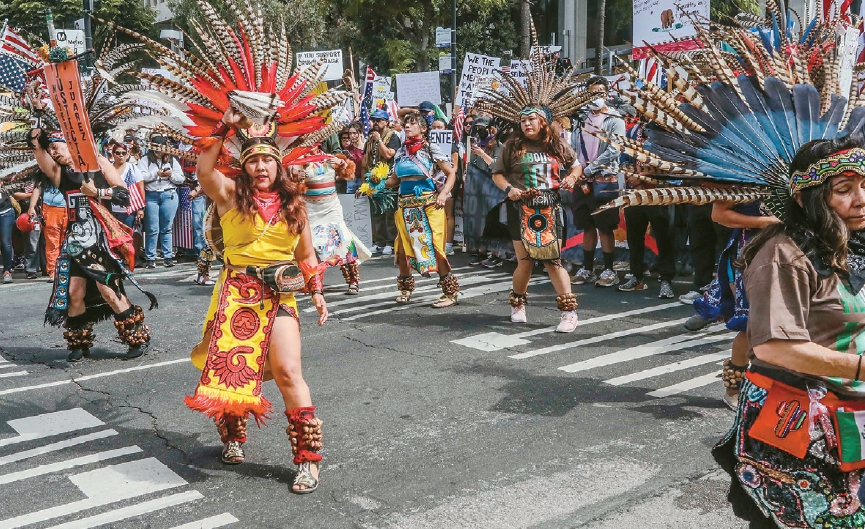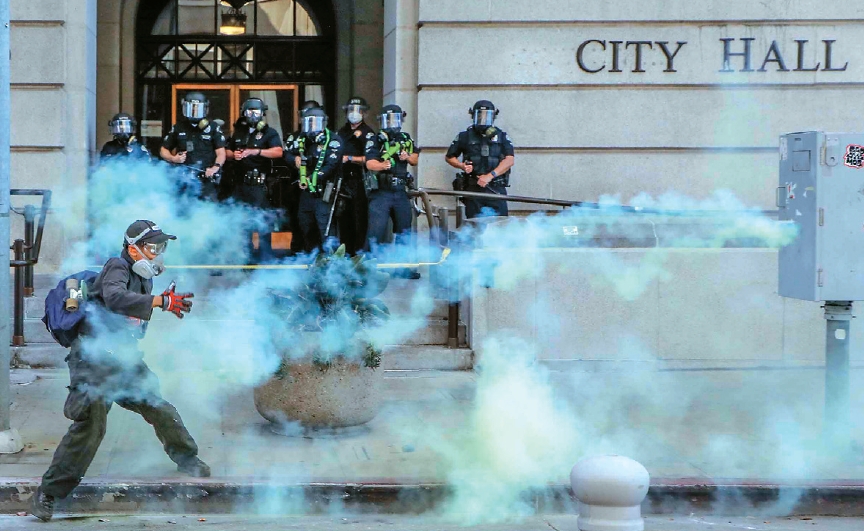“There Are No Kings!” – Downtown LA Erupts on Trump’s 79th Birthday
June 14, the 79th birthday of President Donald Trump and the 250th anniversary of the U.S. Army, began in downtown Los Angeles not with celebration—but with resistance. From first light, the plaza outside LA City Hall erupted with chants and footsteps. Tens of thousands poured in. By noon, it felt like a street festival. By late afternoon, it had turned into something else entirely—tear gas, rubber bullets, screaming chaos.

Crowds swelled through the morning. Flags flew—American, Mexican, Honduran, Palestinian. People of every background and generation gathered to denounce the Trump administration’s authoritarianism and immigration policies in a unified voice.
“No Kings!” “ICE Out of LA!” the crowd chanted. This was the LA front of the “No Kings Day” protest, part of a nationwide mobilization held in over 2,000 cities across all 50 states.
At 9:30 a.m.,
demonstrators packed into Spring Street in front of City Hall. Helicopters hovered above as signs and flags filled the square. At 10:40, the march began, stretching down Broadway to Pershing Square, led by drums and brass horns. A large sign read: “No throne. No crown. We are the people.”
When they reached Pershing Square, protesters gathered around a massive cloth banner and covered it with handwritten messages.
“America stands for justice.”
“No human being is illegal.”
Message after message, the banner filled with demands, anger, and hope. The crowd spilled into every street. It looked like well over 100,000.
Among the marchers were Korean Americans. Yunkyung Sunwoo held a sign in bold Hangul: “Trump’s lies tore families apart.”
“We’re all immigrants,” she said. “I came because I couldn’t just watch families being separated like this anymore.”
At one edge of the square, Latino demonstrators in traditional dress played drums and flutes, performing ceremonial dances. Until noon, the scene felt celebratory. Children waved flags. Music rang out. People shouted, laughed, danced. The streets felt alive.
Then the air changed.
By 2 p.m.,
tension was rising near the ICE federal building.
The crowd moved in. Police lines gave way. Protesters crossed the yellow tape and surged forward. They stood face-to-face with soldiers and shouted:
“Shame on you!”
“Go guard Trump!”
More than 60 Marines, armed and expressionless, stood guard at the building steps. The California National Guard blocked the federal courthouse, and CHP patrols sealed off the 101 freeway onramp.
Outside the ICE building, John Lowry shouted through a megaphone.
“ICE agents are grabbing pregnant women, seniors, students—anyone. No cause. No reason. We’re here to defend our rights.”
Joel Patterson, another protester, stood just behind him.
“The National Guard. The Marines. They’re supposed to protect us. But now they’re threatening us. I don’t even know anymore—are they the people’s army? Or Trump’s army?”
He paused.
“This is the collapse of American democracy.”
By 4 p.m.,
police issued a dispersal order. Dozens of cruisers blocked the streets. Armed officers advanced.
“Move back! Move back!” they yelled.
No one moved.
Then the tear gas hit.

Canisters exploded. Rubber bullets flew. Batons came down. Screams echoed through the smoke. Police charged, breaking the crowd apart by force. The mounted unit galloped forward—horses slamming into the pavement. In seconds, the square was chaos.
One man went down. A rubber bullet had hit him in the chest.
Protesters rushed in—pressed gauze to the wound, dragged him into the shade, poured water over his face.
Along Broadway, tear gas filled the air. People flushed their eyes with water. Volunteers moved in with spray bottles and wipes.
A voice rang out over a loudspeaker:
“If you’ve been gassed, come this way!”
By 7 p.m.,
the crowd in front of ICE had mostly cleared.
But many didn’t go home.
Groups moved south.
The march continued.
Police followed close behind. Tension stretched across downtown.
By nightfall, Downtown LA and Chinatown stood silent.
Empty. Still.
Just hours earlier, the streets had thundered with protest.
Now, they were quiet as a ghost town.
BY KYEONGJUN KIM [kim.kyeongjun1@koreadaily.com]
AND HANKIL KANG [kang.hankil@koreadaily.com]




